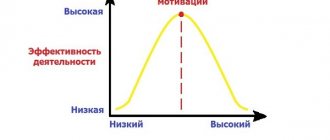- Tweet
- Share 0
- VKontakte
- 0
- Login to have your vote counted
We have already told you how to plan and implement goals using proven tools: mind maps, the Eisenhower matrix, etc. You will significantly increase the effectiveness of your actions if you change your attitude towards life - look at everything through the prism of Pareto’s law.
Deeper about the Pareto 80/20 principle
Many asymmetric examples can be given. But this idea needs to be used with caution. Many people are mistaken in thinking that 20 and 80 add up to make 100. Numbers don't do that!
Let's look at a simple example. Workers, 20% of them, create 30% of the result. Can they? It could be 50, 60, 80 or 100%. In a team of 100 people, let 20 workers do all the work. And the remaining 80 workers do nothing. It turns out that it was 20% of the workers who did 100% of the work.
Therefore, the 20/80 rule, or vice versa, is too rough a guide to a typical distribution. Even the numbers themselves, 20 and 80, should not and are not accurate. Most things in the world and in the private lives of each of us are distributed unevenly. It is a fact that some people contribute more than others.
What does uneven distribution of things mean? The key factor here is that each unit of work cannot contribute the same amount.
Of course, it would be ideal: every employee put in the same amount of effort, every feature was equally valued by users, every miss was equally important. Planning is then very easy! But in reality this is not always the case.
According to the Pareto rule, most things are not evenly distributed . Out of 10 ideas, 1 will be successful. This successful thing/idea leads to the green line, the majority of the group's influence.
But, there is always a desire for life to resemble the red line. Where the investments of each part go equally. And this often doesn’t always happen.
Origin, childhood
Wilfredo was born into a noble family living in Paris. His father was an Italian marquis, expelled from Italy for his republican and liberal beliefs. Pareto's mother is French. Wilfredo, who since childhood was fluent in both languages of his parents, still felt more Italian than French. In 1850, the family was allowed to return to Italy, and it was with this country that the further life of Vilfredo Pareto was connected (childhood, youth and part of his mature period).
80/20 lifestyle
To start living 80/20 today, all you need to do is focus your energy on what you love.
A part-time job is a part-time passion.
Many people work full time and work after hours to pursue a business, hobby or creative talent. If this applies to you, then most likely your ratio is not 80/20, but most likely closer to 20/80.
You spend too much time doing a job you don't enjoy, you're probably not very motivated to do it well, so you're not in the vital 80/20 of employees for that company, and by the time you get home, you're You will be too tired to spend time on your hobbies. You feel like you're going nowhere fast.
This lifestyle is not suitable for anyone, since all relationships fall into the 80 percent that produce 20 percent of the value. You get very little out of it, and the people you work for get very little out of you.
If all of the above describes your situation, then you need to start changing these ratios. Reduce the time you spend doing work you don't enjoy and increase the amount of time you spend doing the things you love.
You'll say you can't do it because you need the money, but I suspect you don't actually need as much as you think.
Most people can live off part-time work, but choose to work more because they want more. You may see your peers enjoying material goods, which creates desires in you.
Your wants begin to outweigh your needs, which is probably the biggest pitfall in our modern, advertising-driven, materialistic society.
Of course, you don't have to live like a beggar, but your real happiness comes from spending your time doing the things you enjoy most, not making more money.
Chasing a dollar for the sake of a dollar doesn't work. Chasing your passion often leads to more income because the quality of your products improves.
Focus on increasing investment in your core strengths and you will reap the rewards.
Reduce your work hours to three days a week and spend more hours on getting clients, booking concert tickets, finding time to write a novel, developing your invention, coding your software, finding investors, or whatever. you really want to do.
For those of you who have no intention of turning your passions into profitable, money-generating ventures, this is still a good option. If money is not your main concern, but music is, for example, why do you spend so much time trying to make more money than you need?
Yes, it is important to plan for the future and build assets, but obviously for your musical soul this is not something that should take up the majority of your time and energy. You may be happy without that mansion by the sea, and you'll never know if you spend more time on your music, eventual album sales might one day lead to that mansion by the sea.
If not, then at least you will be much happier if you follow your passion rather than money.
If financial freedom is important to you and most of your plans are considered at this stage as the first stage and work on converting your passions into income-generating offerings.
Grow your business client by client, gig by gig or sale by sale. Continue to adjust your work-to-hobby ratio as your business grows to support you so you no longer need your income from work. Look for 80/20 action in everything you do and eliminate inefficiencies whenever you can.
Reasons for turning to sociology
As mentioned above, Pareto turned to sociology rather late, being already a well-known specialist in the field of political economy. What was this connected with? Probably because Wilfredo was no longer satisfied with the concept of “economic man,” which was rationalistic and within which the scientist worked for a long time, studying the monopolistic market, as well as the distribution of income in society and some other economic problems. Even in the works created in the late 19th and early 20th centuries, the author’s interest in a new model of man is noticeable. This interest was fully realized in the “Treatise on General Sociology” - a voluminous work (about 2000 pages of text).
Pareto principle in everyday life
It is impossible to radically improve the quality of life without changing the way you think and act. It has long been noted that in the pursuit of happiness and success, in most cases we make much more effort than necessary. In fact, in order to stop the daily “mouse fuss” and find a feeling of happiness in the near future, it is often enough to do only the little that gives us pleasure.
As Richard Koch, author of the bestselling books “The 80/20 Principle” and “Living by the 80/20 Principle,” explains, the principle is based on two main postulates: A. The Law of Focus: Less is more. B. Law of Progress: More is created through less.
The idea of focus comes down to the fact that correct focusing and putting 20% of our efforts into action allows us to realize 80% of our desires. Efforts made beyond this 20% often result in wasted time and effort. Correctly focusing attention and effort means being able to identify things that are of primary importance to us, the main values that fill life with meaning and vibrant content. With this skill comes an understanding of the law of focus - less is more.
The idea of progress states that we can achieve and gain more with less time and effort. We really don't have to do everything. It is necessary and sufficient to learn to do only what brings results. This is the essence of the Pareto principle, which in its original version sounds like this:
“20% of effort produces 80% of the result, and the remaining 80% of effort produces only 20% of the result.”
Learning to use this rule, ingraining it in habits, way of thinking and actions means completely and qualitatively changing your life, gaining those advantages that 80% of our surroundings pass by every day and habitually. With a creative, correct approach, the principle works in business, self-improvement, relationships, social models - almost everywhere where a person and his vital interests are present in one way or another.
"Treatise on General Sociology"
Wilfredo had to interrupt his teaching career in 1907 due to heart disease. After some time, feeling an improvement in his health, he set to work on his “Treatise on General Sociology.” Wilfredo wrote this work for 5 years, from 1907 to 1912. In 1916, its first publication took place in Italian, and 3 years later the Treatise was published in French. Vilfredo Pareto from that time until the end of his days was engaged in research only in the field of sociology. At the University of Lausanne in 1918, his 70th anniversary was solemnly celebrated.
How the 80/20 principle works
It is worth looking around carefully and impartially and we will come to the conclusion: in various spheres of life, the Pareto principle, to some approximation, manifests itself with amazing consistency. The accuracy of this relationship may vary, but the main conclusion always works: the majority of effects manifested are the result of a minority of causes.
The Pareto principle is applicable both in a professional environment and in personal life. The main thing is to understand that at every moment in time we can determine and use for ourselves that little that can give us a lot. On the other hand, by simplifying life, by sweeping out of it what does not work and does not correspond to our values, we can more easily identify the small things that are valuable and achieve the desired big results with their help.
Example. You can spend the day with a loved one, but in the evening you hear from him that you have been paying almost no attention to him lately. Or you can give him just one hour instead of four, and he and you will remember this hour for the rest of your life. The secret is simple: in the first case, you actually didn’t devote a single minute to it, periodically being distracted by TV, phone calls or discussing empty, unimportant things. In the second, they gave the person all their attention, placing emphasis on the quality of communication, and not on the number of hours spent together.
In solving relatively simple problems, where the main criterion for success is a quantitative factor, indeed, it is often possible to determine for yourself those 20% of reasons that will allow you to achieve 80% of the result or get closer to the ratio of 20/70, and in exceptional cases, to 10/90 . Strictly speaking, it is more correct and useful to get rid of the rigid percentage ratio and be guided by the logic of the principle itself. And this is quite enough to get closer to your goal much faster, more efficiently and more comfortably. Let's back this up with examples...
Acquaintance with the works of Italian economists, a change in beliefs
In 1891, Pareto became acquainted with the works of two prominent Italian economists, L. Walras and M. Pantaleoni. The theory of economic equilibrium developed by them had a great influence on Wilfredo's worldview and subsequently formed the basis of his own sociological system. The beginning of the 90s of the 19th century saw a turning point in Pareto’s beliefs. The scientist took the position of anti-democracy and conservatism. Between 1892 and 1894, Pareto published a number of his materials on economic theory.
The 80/20 principle and language learning
In the arsenal of many existing languages, you can count up to more than a million words. From the point of view of the Pareto principle, the word superfluous is not an exaggeration at all. For real everyday communication, a few hundred and, even more so, a few thousand are often enough for us.
Having replenished your vocabulary with several thousand frequently used words, you will be able to communicate at an everyday level. Of course, to communicate on highly specialized topics you will have to expand your knowledge, but in all other cases this additional knowledge will most likely remain unclaimed. This way, you deliberately lower the bar by focusing on the speaking aspect and achieve the result you want without much effort in just a few months. The main condition for achieving results is not the dull memorization of hundreds of stillborn words, but the practice of live communication with native speakers.
Memo
To achieve success using Pareto's Law:
- Make efforts in those areas of life where your abilities will provide the best results at minimal cost.
- Identify resources that will help you move toward your goal most effectively. Strengthen and develop them.
- Don't waste time on ineffective resources.
- Of all the paths that lead to your goal, choose the shortest. Let the result be not 100%, but 80%, but you won’t have to wait long, and there will be time to conquer new heights.
Do you use Pareto's law in life? What principles do you follow to be more effective?
- Tweet
- Share 0
- VKontakte
- 0
- Login to have your vote counted
Pareto's Law and Diet
In order to achieve dramatic improvements, it is enough to change your daily diet at the initial stage of maintaining the diet by only 20%. So, if you are a supporter of the paleo diet (the diet of our ancient ancestors), to achieve the effect, it is enough to exclude dairy and grains from the diet. Then whether you continue to eat legumes or not will not affect the final result. It is important to use the principle here - not to think about how many kilograms you will lose in a month if you completely rebuild your entire diet, but to exclude several ingredients from your daily menu that can bring tangible results in the foreseeable future. Further, based on it, you can achieve big changes in the future.
Why spend hundreds of dollars on exotic juices and cleanses when you can eliminate grains and dairy for at least a month? Experiment and see for yourself...
last years of life
The Italian sociologist published several interesting and important works in the early 1920s. In 1921, “Transformation of Democracy” was published in Milan, which summarized all the main ideas of this scientist. The sociologist in several of his works sympathized with Italian fascism, for which he expressed ideological support. It was at this time, in 1922, that B. Mussolini (pictured above) came to power in Italy. The new government honored Pareto, many of its members, including the Duce himself, considered themselves students of Vilfredo. Pareto became a senator of the Kingdom of Italy in 1923. Then he died in Seligny and was buried here.
Pareto's Law and Fitness
Tangible and pleasant progress in fitness can be achieved anywhere, without a complex training program, outside a gym equipped with hardware and electronics and a “currency” trainer. You can achieve results using your own weight and sprinting. You just need to start working on a few exercises, concentrate on them and make them a habit. Work with your weight for a month for 20 minutes a day, combining exercise with diet and sprints, and then evaluate the result.
To increase profits
Let's say you have a store. Now you know that only 20 percent of the product makes up the entire profit. It's not hard to calculate. what goods these are (mostly the cash register is made up of cigarettes, bread, alcohol, sausages and dairy products - what everyone needs) and place the main bet on them. If there is sausage, then there are 20 types, if there is kefir, then there are ten different manufacturers to satisfy the tastes of even the most capricious buyer. Of course, other goods should be in the store - but in several positions each, so as not to run out of money. It's the same with clients. Here you have your own business - for example, creating landing pages and websites. You have regular clients on whom all your work rests - for example, a marketing agency that often places orders and leaves good sums. Guess how many such clients there are? That's right, plus or minus 20 percent, they need to be licked from head to toe. The rest, of course, also need to be made happy in all available ways, but the main attention should still be paid to the most solvent.
Pareto's Law and Business
Contrary to the popular belief that “the customer is always right,” in practice this rule often does not work. However, customer service managers often receive instructions from management to retain clients at literally any cost, even if they delay settlements, accompanied by constant dissatisfaction with staff. With minimal conversion, the real loss from one such client can amount to tens of thousands of dollars. Concessions in the form of loyalty programs, etc., do not change the situation. Such clients certainly fall into the category of those who are determined to pay less and get more, slowly but surely tightening the noose around the neck of even the most successful business.
In order to radically change the situation, it is enough to simply get rid of such clients, adding preferences to those remaining who are loyal to the company and bring it a constant income, without burdening management with headaches.
Interesting statistics confirming the effectiveness of the 80/20 principle have been collected for many areas of our lives. Eg:
- If you're a blog author, you've probably noticed that 80% of your valuable traffic comes from 20% of your posts.
- If your business is related to trade, then you get 80% of your profit from selling 20% of your product line.
- The item spending 20% of your bills is 80% of your total expenses.
Having a website on the Internet, you don’t need to focus on all marketing channels - it’s enough to evaluate the existing statistics on the main sources of traffic for 90 days and concentrate all your attention and resources on them. The rest, at least temporarily, can be left behind. Evaluate the result after 90 days.
Analyzing sources of income and comparing it with the amount of effort applied per person sometimes leads to unexpected results. You may find that you are systematically passing up an easy, accessible, and fast income stream that is literally just an arm's length away. By focusing on the flows that significantly cover the entire investment, at the same time get rid of unprofitable or sluggish unpromising channels. Evaluate the result after 3 months.
There are no and cannot be perfect people, as well as the results of their work. In most cases, it is enough to have a good result and remember that the perfectionist inside you and enjoying absolute power over your time, emotions and energy is the strongest inhibitor on the path to your effectiveness and satisfaction with life. Learn to settle for “good” rather than “flawless.”
Any of our undertakings can be analyzed from the point of view of the Pareto principle and we can determine for ourselves the key points of application of efforts. Caution in using the Pareto criterion is required when we have to carry out a complex, responsible task, where we will have to give our all. Here, the quality of the result is given a key priority and sacrificing time and effort even in one, even difficult, aspect means questioning the success of the entire endeavor.
There are exceptions to every rule. Perhaps you are a conductor, general designer or, for example, a sign language interpreter voicing text at a memorial ceremony. In this case, knowing the basics of your profession in detail does not imply compromise. Unless, of course, you are interested in communicating with your audience in sign language, like this guy:
Practical part
Friends, learning to apply the Pareto Principle in life is only half the success. The second half of success is setting goals correctly and moving in the right direction. If you want to become more effective in work and life, learn to set goals and accomplish more in less time, I recommend the “Goal Setting” course from Vikium.
This course will help:
- Not only to dream, but also to realize
- Get inspired for new goals
- Be more positive on the way to your goal
What does the course consist of:
- 6 lessons
- Practical exercises and recommendations
- Video materials
- Graphic diagrams and tasks
You can:
- Achieve your goals
- Don't waste energy
- Carry out your plans
- Setting new standards in development
- Fulfill your dreams
The most valuable investment is an investment in yourself!
Disadvantages of the principle
Of course, nothing is ideal in the world, and the Pareto rule is no exception. The main disadvantage is already built into the very basis of the rule, namely the ratio of 80 to 20. This means that no matter how much effort you make, it will be impossible to achieve 100 to 0, i.e. impeccable efficiency. You can differentiate activities indefinitely, but the ideal result will remain unattainable. Whatever one may say, in any case you will have to spend 80% of your efforts on unnecessary actions and somehow you will not be able to avoid this. However, this rule still remains one of the most effective laws in the modern world.
A striking example of why the ideal cannot be achieved can be demonstrated in business. Imagine that 20% of products account for 80% of a company's profits. You can, of course, remove the remaining twenty percent, but you still won't be able to receive 100% of the revenue. And that's why. In the market, marketers have long come up with the idea of dividing goods into segments: expensive and cheap. So, for example, it is expensive products that will provide 80% of revenue. But if you “take off” cheap goods from the shelves, then, firstly, luxury goods will also become ordinary, since there is simply nothing to compare with. When a wealthy person sees a cheap product, he will by default choose a more expensive one, since a budget product will not be premium for him. For him, quality and status play an important role.
The opposite is also true; for a buyer with a low income, a cheap product will seem affordable. If he cannot compare, then he will not be able to reliably determine that the product in front of him is from the budget category. This consumer prefers accessibility in order to save money. Try to remove even one component, and the formula will become unusable.
Elite theory
Pareto is the creator of the theory of elites. He talked about their constant change. The Italian researcher called history a cemetery of elites, privileged minorities fighting for power, coming to power, enjoying power and being replaced by other minorities. Wilfredo noted that elites tend to decline. In turn, the “non-elites” are able to create worthy successors for them. This is important because often children do not have the outstanding qualities of their parents. The need for circulation and constant change of elites is explained by the fact that those in power are losing the energy that helped them win their place in the sun.
Interchangeability
This rule can also be applied to identify negative factors. For example, 20% of your shopping categories make up 80% of your spending. Nowadays, almost everyone has banking apps that provide detailed statistics on your spending. If you don't have such an app or it doesn't support spending analysis, there are many such programs available in app stores. Analyze your expenses and you will understand where the bulk of your budget goes. By doing this, you can cut down on unnecessary expenses and reallocate your budget to more important purchases.
Psychological inequality of people
The theory of Vilfredo Pareto pays special attention to the motives of human actions, therefore, for the Italian scientist, politics is largely a function of psychology. Using a psychological approach in the analysis of politics and society, Wilfredo explained the diversity of social institutions by the psychological inequality of people. He noted that society is heterogeneous, and individuals differ morally, physically and intellectually. It can be considered that Wilfredo defined the elite by innate psychological properties. He even created a point system of assessments, which identified a person’s abilities in a particular field of activity.
Two types of elite
In Pareto's theory of the elite, there are 2 types of it: “foxes” and “lions”. If the political system is stable, the “lions” prevail. An unstable system requires strategists, innovators, and energetic people, which is why “foxes” appear. The replacement of one elite by another is the result of the fact that each of these types of elites has its own advantages. However, over time they cease to satisfy the needs of leadership of the masses. Maintaining the balance of the system therefore requires a constant change of elites as repeated situations arise before them.











